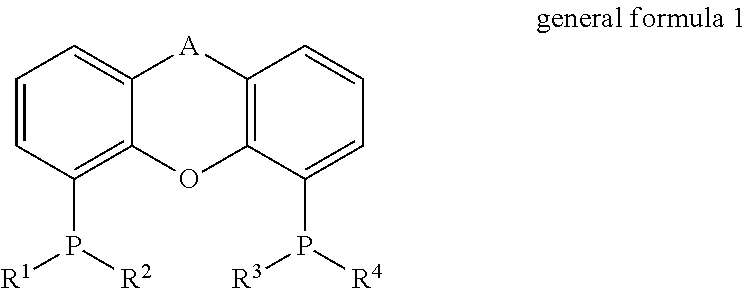Process for the direct amination of alcohols using ammonia to form primary amines by means of a xantphos catalyst system
a technology of xantphos and catalyst system, which is applied in the preparation of amino-hyroxy compounds, functional group formation/introduction, organic compound preparations, etc., can solve the problems of high temperature, use of alkenes and alkanes, and heterogeneous catalysis of gas-phase processes
- Summary
- Abstract
- Description
- Claims
- Application Information
AI Technical Summary
Benefits of technology
Problems solved by technology
Method used
Image
Examples
example 1
Direct Single-Stage Amination of the Primary OH Group of Methyl 12-hydroxydodecanoate by Means of Ammonia over a Homogeneous, Nitrogen-Free Ru-Xanthenyl Catalyst, According to the Invention
[0058]0.23 g of methyl 12-hydroxydodecanoate (1 mmol), 0.057 g of carbonylchlorohydridotris(triphenylphosphane)ruthenium(II) as precursor compound, 0.035 g of 9,9-dimethyl-4,5-bis(diphenylphenylphosphino)xanthene as ligand and V (see Table 1) ml of 2-methyl-2-butanol were placed in a 50 ml high-pressure reactor and flushed with nitrogen in the closed and gastight reactor at room temperature. 1.5 ml of liquid ammonia were then introduced over a period of 0.15 minutes and the reaction mixture was heated to TC (see Table 1), with a pressure of up to 35 bar being established. After a reaction time of 20 hours, the reactor was cooled, depressurized, the reaction mixture was taken up in ethanol and filtered. According to the NMR analytical results shown in Table 1, the substrate can be successfully conv...
example 2
Direct Single-Stage Amination of the Secondary Alcohol Isosorbide by Means of Ammonia over a Homogeneous, Nitrogen-Free Ru-Xanthenyl Catalyst, According to the Invention
[0059]0.146 g (1 mmol) of isosorbide, 0.057 g of (0.06 mmol) of carbonylchlorohydridotris(triphenylphosphane)ruthenium(II), 0.035 g (0.06 mmol) of 9,9-dimethyl-4,5-bis(diphenylphenylphosphino)xanthene and 1 ml of tert-amyl alcohol were placed in a 50 ml high-pressure reactor and flushed with nitrogen in the closed and gastight reactor at room temperature. 1.5 ml of liquid ammonia were then introduced over a period of 0.15 minutes and the reaction mixture was heated to 150° C., with a pressure of up to 35 bar being established. After a reaction time of 20 hours, the reactor was cooled, depressurized, the reaction mixture was taken up in ethanol and filtered. According to NMR analysis, the alcohol groups are reacted to an extent of 90% and the corresponding primary amino groups are obtained in a yield of 70%; no second...
example 3
Direct Single-Stage Amination of 2-Octanol by Means of Ammonia over a Homogeneous Ruthenium Catalyst
[0060]Under an argon atmosphere, mo g of 2-octanol, mRu g of [carbonylchlorohydridotris(triphenylphosphane)ruthenium(II)] as catalyst, mP g of 9,9-dimethyl-4,5-bis(diphenylphosphino)xanthene and Vsolv ml of 2-methyl-2-butanol as solvents were introduced into the glass liner of a 100 ml Hastelloy autoclave. The autoclave was closed, pressurized three times with 20 bar of argon and depressurized each time and once again pressurized with 15 or 30 bar of argon. mA g of liquid ammonia were then introduced into the autoclave. The reaction mixture was stirred at room temperature for 10 minutes (600 rpm), subsequently heated while stirring to an internal temperature of 170° C. and maintained at this temperature for 48 hours, with a pressure of p bar being established. After cooling to room temperature, careful depressurization of the mixture and pressurization with 20 bar of argon three times...
PUM
| Property | Measurement | Unit |
|---|---|---|
| Temperature | aaaaa | aaaaa |
| Temperature | aaaaa | aaaaa |
| Temperature | aaaaa | aaaaa |
Abstract
Description
Claims
Application Information
 Login to View More
Login to View More - R&D
- Intellectual Property
- Life Sciences
- Materials
- Tech Scout
- Unparalleled Data Quality
- Higher Quality Content
- 60% Fewer Hallucinations
Browse by: Latest US Patents, China's latest patents, Technical Efficacy Thesaurus, Application Domain, Technology Topic, Popular Technical Reports.
© 2025 PatSnap. All rights reserved.Legal|Privacy policy|Modern Slavery Act Transparency Statement|Sitemap|About US| Contact US: help@patsnap.com



